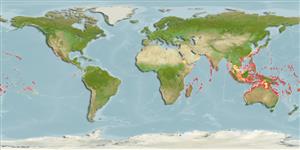>
Gobiiformes (Gobies) >
Microdesmidae (Wormfishes) > Ptereleotrinae
Etymology: Ptereleotris: Greek, pteron = wing, fin + The name of a Nile fish, eleotris (Ref. 45335).
More on author: Bleeker.
Environment: milieu / climate zone / depth range / distribution range
Ecologia
marinhas associadas(os) a recifes; intervalo de profundidade 5 - 80 m (Ref. 128797), usually 5 - 15 m (Ref. 27115). Tropical; 22°C - 27°C (Ref. 27115); 35°N - 35°S
Indo-Pacific: Red Sea and East Africa to the Hawaiian, Line, Marquesas, and Society Islands, north to the Ryukyu Islands, south to Lord Howe Island; Mariana, Caroline, and Marshall Islands in Micronesia.
Tamanho / Peso / Idade
Maturity: Lm ? range ? - ? cm
Max length : 14.0 cm TL macho/indeterminado; (Ref. 2798)
Espinhos dorsais (total): 7; Raios dorsais (total): 29-33; Espinhos anais 1; Raios anais : 27 - 30; Vértebras: 26. Light blue to pale bluish gray; upper edge of operculum with a longitudinal iridescent blue band divided into 2 sections. Caudal fin yellowish, some with an orangish streak passing anteriorly from spot; 1st dorsal fin not as high as the 2nd; 2nd dorsal and anal fins not elevated anteriorly; pelvic fins not long; base of pectoral fin usually with a blue-edged salmon-pink spot.
Occurs in lagoons or bays, in passes, or on outer reef slopes; over hard substrate as well as patches of rubble or sand, usually at the base of the reef. Adults are usually in pairs and share burrow which is often under a piece of rubble or slab of coral rock. Adults feed on current-borne zooplankton as high as 3 m above the burrow; tend to remain together while feeding, separated by not more than 1-2 m. Monogamous (Ref. 52884, 48637). Juveniles occur in large groups, as many as 500. Minimum depth reported from Ref. 27115.
Ciclo de vida ou comportamento de acasalamento
Maturidade | Reprodução | Desova | Ovos | Fecundidade | Larvas
Randall, J.E. and D.F. Hoese, 1985. Revision of the Indo-Pacific dartfishes, genus Ptereleotris (Perciformes: Gobioidei). Indo-Pac. Fish. (7):36 p. (Ref. 528)
Status na Lista Vermelha da UICN (Ref. 130435)
Ameaça para os humanos
Harmless
Uso pelos humanos
Aquário: Espécies comerciais
Mais informação
ReferênciasAquaculturaPerfil para aquaculturaEstirpesGenéticaElectrophoresesHereditariedadeDoençasProcessamentoNutrientsConversão de massa
ColaboradoresFotosStamps, Coins Misc.SonsCiguateraVelocidadeTipo de nataçãoÁrea branquialOtólitosCérebrosVisão
Ferramentas
Relatórios especiais
Baixar XML
Fontes da internet
Estimates based on models
Preferred temperature (Ref.
123201): 24.5 - 29.2, mean 28.1 °C (based on 2894 cells).
Índice de diversidade filogenética (Ref.
82804): PD
50 = 0.5000 [Uniqueness, from 0.5 = low to 2.0 = high].
Bayesian length-weight: a=0.00389 (0.00180 - 0.00842), b=3.12 (2.94 - 3.30), in cm total length, based on all LWR estimates for this body shape (Ref.
93245).
Nível Trófico (Ref.
69278): 3.4 ±0.45 se; based on food items.
Fishing Vulnerability (Ref.
59153): Low vulnerability (10 of 100).
Nutrients (Ref.
124155): Calcium = 104 [55, 171] mg/100g; Iron = 0.801 [0.485, 1.321] mg/100g; Protein = 18.1 [17.0, 19.2] %; Omega3 = 0.0967 [, ] g/100g; Selenium = 30.9 [14.9, 63.9] μg/100g; VitaminA = 187 [66, 557] μg/100g; Zinc = 1.77 [1.19, 2.47] mg/100g (wet weight);
